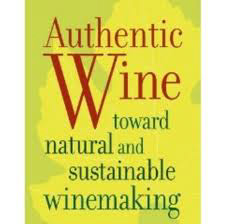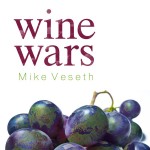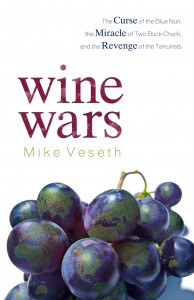Tag: Wine Wars
A Holiday Book List for Wine Lovers
With the holiday season upon us, I can’t think of a better gift for someone you love (or even someone you don’t like all that much, but for some reason are obligated to buy a gift for) , than a book about wine, save perhaps for a bottle of the actual stuff. In the time since I started writing this blog, I’ve read a fair number of books on this subject, many of them about the process of growing grapes and turning them into wine, others on the joys of drinking wine, and still others on some topical issue, such as the touchy subject of natural wine.
With that in mind, I thought I’d list a few books that might make a nice gift for a friend or stocking-stuffer (yes, I know, that would be some big stocking – but you can just leave it under the tree). Most of these are books I’ve read and enjoyed, and some are volumes that I’ve put on my own list. Among those in the category of books I’ve loved, I’ve either reviewed them or have plans (and yes, I have more plans than time) to write a review on Project Sunlight. So, stay tuned. Meanwhile, here’s the list:
Some Books I’ve Loved
Of all the books I’ve read about wine, I’ve enjoyed none more than Authentic Wine by Jamie Goode and Sam Harrop MW (Master of Wine).  The book’s subtitle, Toward Natural and Sustainable Winemaking, gives a broad hint about where it’s heading, but one of the most appealing things about the book is its balance. The authors clearly respect the idea of natural wine and sustainable viticultural practices, but their first priority appears to be good wine, and they understand that a business isn’t sustainable if it isn’t profitable. Authentic Wine falls neatly into two parts, one dealing with viticulture and the second focusing on winemaking. I’ve read this book twice (you’d think after that I’d have taken the time to write at least a short review), and I’ll will probably read it yet one more time. They write intelligently and lucidly about a variety of current issues in the wine world, from reduction to the difference between natural and cultured yeasts to the trend toward riper fruit and higher alcohol levels. The get into the science and technical issues, but the writing is accessible and easy to follow. That’s quite a rare feat, and one of the reasons I’m so high on Jamie Goode.
The book’s subtitle, Toward Natural and Sustainable Winemaking, gives a broad hint about where it’s heading, but one of the most appealing things about the book is its balance. The authors clearly respect the idea of natural wine and sustainable viticultural practices, but their first priority appears to be good wine, and they understand that a business isn’t sustainable if it isn’t profitable. Authentic Wine falls neatly into two parts, one dealing with viticulture and the second focusing on winemaking. I’ve read this book twice (you’d think after that I’d have taken the time to write at least a short review), and I’ll will probably read it yet one more time. They write intelligently and lucidly about a variety of current issues in the wine world, from reduction to the difference between natural and cultured yeasts to the trend toward riper fruit and higher alcohol levels. The get into the science and technical issues, but the writing is accessible and easy to follow. That’s quite a rare feat, and one of the reasons I’m so high on Jamie Goode.
Also high on my list is Mike Veseth’s wonderful discussion of current wine industry trends, Wine Wars. (Reviewed March 28, 2013) Subtitled, “The Curse of the Blue Nun, the  Miracle of Two-Buck Chuck, and the Revenge of the Terrorists,” this book ranges over a great deal of history to put some of the trends into context, and provides a lot of insight into some of the things, like Trader Joe’s and Costco, that are right in front of our eyes. Could a two-dollar (somewhat more outside of California) bottle of wine have succeeded if it had been sold anywhere else but at Trader Joe’s? In a world in which quality is often equated to price, it might not have worked at a retailer that had not already won the trust of its customers. And yet, in Europe, some perfectly drinkable wines sell (or at least sold recently) for a Euro a liter, making it effectively One-Buck Chuck. Mr. Veseth writes with the authority of the wine economist (a profession I did not know existed prior to reading this book), he is, and it’s clear that he not only knows a lot about wine, but that he loves it as well. The fact that his prose is both clear and engaging is just a bonus. Continue Reading–>
Miracle of Two-Buck Chuck, and the Revenge of the Terrorists,” this book ranges over a great deal of history to put some of the trends into context, and provides a lot of insight into some of the things, like Trader Joe’s and Costco, that are right in front of our eyes. Could a two-dollar (somewhat more outside of California) bottle of wine have succeeded if it had been sold anywhere else but at Trader Joe’s? In a world in which quality is often equated to price, it might not have worked at a retailer that had not already won the trust of its customers. And yet, in Europe, some perfectly drinkable wines sell (or at least sold recently) for a Euro a liter, making it effectively One-Buck Chuck. Mr. Veseth writes with the authority of the wine economist (a profession I did not know existed prior to reading this book), he is, and it’s clear that he not only knows a lot about wine, but that he loves it as well. The fact that his prose is both clear and engaging is just a bonus. Continue Reading–>
Wine Wars: Terroir’s Last Stand?
Reading Wine Wars, Mike Veseth’s superb book about the forces shaping the modern wine industry, brought two memories to mind, one of fairly recent vintage, the other decades old.
I’ll start with the older one, which involves a college night with friends. For reasons that I’m sure made good sense at the time, we decided it would be fun to buy a bottle or two of the cheapest wines we could find on the shelf at a nearby 7-Eleven. I don’t remember exactly what we bought or what I drank, but the names Thunderbird, Boone’s Farm, and Blue Nun spring to mind. I also can’t recall how much we paid for them, but it seems like they must have been a couple of dollars each, in line with the cost of a six-pack of beer in the late 1970s. And, oh yes, I vaguely recall waking up the next morning with a killer hangover.
The more recent memory involves a lunch in Madrid a couple of years ago. On the way  to the Prado museum, we stopped at a nearby restaurant for a quick lunch. I ordered the menu del dia, or menu of the day, a common offering at Spanish restaurants that generally features a soup or salad, an entrée, a desert and a choice of beverages. When I asked about the choice of beverages, I was offered soda of some kind, water, coffee, tea, or wine. Naturally, I asked for red wine, pleasantly surprised, but realistic enough to expect nothing more than a glass of something that would be innocuous at best.
to the Prado museum, we stopped at a nearby restaurant for a quick lunch. I ordered the menu del dia, or menu of the day, a common offering at Spanish restaurants that generally features a soup or salad, an entrée, a desert and a choice of beverages. When I asked about the choice of beverages, I was offered soda of some kind, water, coffee, tea, or wine. Naturally, I asked for red wine, pleasantly surprised, but realistic enough to expect nothing more than a glass of something that would be innocuous at best.
A few minutes later, the waiter brought a bottle to our table, set it down, and said something that I took to mean, “this bottle is all for you.” When I questioned him, he repeated the phrase. And I understood. Yes, it was mine, all mine. The entire bottle.
The meal probably cost 8 or 9 Euros, about $11 or $12 at the current exchange rate, at the bottom end of what I would expect to pay in any major U.S. city for a decent lunch at a nice, but inexpensive restaurant. Two things struck me about that transaction. First was the recognition that back home, the price of the meal would barely have covered a glass of wine, if that, along with a decent course or two of food. But what really surprised me was the casual way they threw in the full bottle. We’re talking wine, after all, not water from the tap.
I wondered off and on in the intervening years how it could be possible to serve a bottle of wine with a meal as though it was nothing more than a cup of bad coffee. Wine Wars gave me some answers.
Mr. Veseth discusses three major trends shaping the world of modern wine: globalization, “the miracle of Two Buck Chuck,” and what he refers to as “the revenge of the terroirists.” Continue Reading–>



Recent Comments